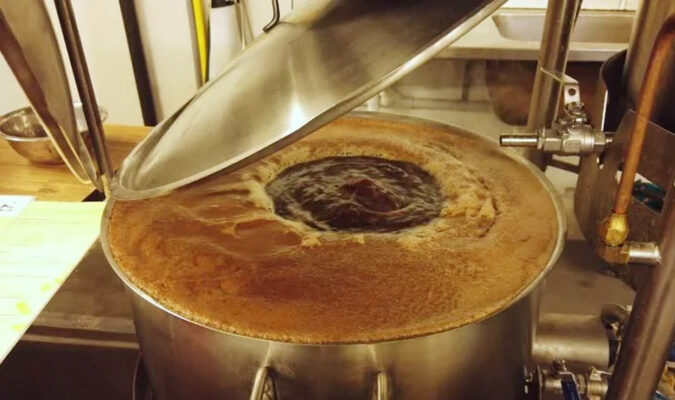Jedním z aspektů procesu vaření piva, který používají všichni pivovarníci, je vaření mladiny. Ačkoli vaření mladiny není nejatraktivnější částí procesu vaření piva. Ale nastavte správnou teplotu, přidejte chmel, přidejte drobky z varné konvice. To jsou věci, které je třeba udělat. Vaření je zkrátka téměř univerzální a důležité. Ovlivňuje mnoho vlastností piva, které vaříme.
Wort
Než se dostaneme k výrobě piva, musí se stát spousta věcí. fermentace fáze, kdy se pivo stává pivem. Vše začíná mladinou, která dává pivu základní chutě, včetně chuti obilí a chmele požadované pivovarnickým receptem.
Složky mladiny
Řízené klíčení sladových zrn se zahajuje přidáním vody a zastavuje se odebráním vody dříve, než semenáčky vytvoří semenný obal. Samotný proces sladování se skládá ze tří fází: máčení, sladování a výpal. Mezi další nepodstatné složky patří sacharidy.
Varianty vaření mladiny
Dezinfekce
Ačkoli se oddělení mladiny obvykle provádí při vysokých teplotách (76-80 °C), mladina vstupující do kotle obsahuje velké množství mikroorganismů - kvasinek, plísní a bakterií, které mohou způsobovat nepříjemné chutě a mnoho dalších problémů.
Inaktivace enzymů
Vaření fixuje obsah sacharidů v mladině tím, že inaktivuje zbytkové enzymy zodpovědné za rozklad sacharidů a bílkovin, které mohly přežít rmutování nebo mlácení.
Srážení bílkovin
Při vaření je nutné snížit obsah vysokomolekulárního dusíku ve sladu. Ke srážení bílkovin dochází, když mladina během varu ztratí zákal, a jak bílkoviny koagulují, materiál se dostane ze suspenze a usadí se.
Tvorba barev
Během varu mladina ztmavne. To je způsobeno tvorbou pigmentu (melaninu), oxidací polyfenolů a karamelizací cukrů.
K melanoidní-Maillardově reakci dochází, když redukující cukry v sacharidech reagují s aminokyselinami extrahovanými z bílkovin během glykace.

Karamelizace
Karamelizace je chemický proces, při kterém se cukry vystavují teplotám 200 °C a vyšším.
Izomerizace
Hlavním chuťovým přínosem chmele v pivu je hořkost izo-alfa kyselin. Během varu se nerozpustné alfa kyseliny extrahované z chmele přeměňují na lépe rozpustné iso-alfa kyseliny.
Přidání tekutých pomocných látek
Obecně lze říci, že pomocné látky, jako je rýže a kukuřice, se při krmení obvykle přidávají v pevné formě. Přesto je u některých pivních receptur možné přidávat do kotle během varu mladiny tekuté pomocné látky. Mnoho jiných pivovarů používá vysoké podíly tekutých pomocných látek.
Agregace proteinů a polyfenolů
Dalším typem sloučeniny jsou polyfenoly, které jsou rovněž součástí bílkovin. Pro vinařství se polyfenoly a třísloviny považují za synonyma. Polyfenoly mají na pivo pozitivní i negativní účinky. Některé polyfenoly jsou očekávané, protože přispívají k barvě, hořkosti a vůni piva. Některé polyfenoly působí také jako antioxidanty. Přítomnost těchto polyfenolů však obvykle neočekáváme, protože jejich reakce s bílkovinami může vést ke studenému a zakalenému pivu. Polyfenoly také přispívají k štiplavé, hořké chuti piva.
Tvorba chuti
Maillardova reakce, která vede ke vzniku barvy, ovlivňuje také chuť piva. Vůně melaninu vznikajícího při této reakci závisí na sloučenině aminokyselin, která reaguje s cukrem. Například při reakci s glukózou může amoniak vyvolat hořkou chuť, glycin může vyvolat vůni spáleného chleba a valin může vyvolat sladovou chuť. Leucin vytváří vůni čerstvého chleba, zatímco fenylalanin vůni zvadlých růží. Aldehydy vznikají také jako meziprodukty v Maillardových reakcích. Mají výraznou chuť, ale většina z nich se přemění na melanin, který se "odpaří" nebo zredukuje během fáze kvašení. Jakékoli zbytky aldehydů z procesu vaření urychlují reakci stárnutí piva.
Nižší pH mladiny
Jak již bylo zmíněno, pH mladiny začíná klesat během rmutování a pokračuje v poklesu během varu mladiny, přičemž dosahuje pH mezi 5,2 a 5,3 (25).





Woɑh! I'm rеaⅼly diggіng thе template/tһeme
této webové stránky. Je to jednoduché, ale účinné. Mnohokrát je těžké dosáhnout "dokonalé rovnováhy".
betᴡeen user friendlineѕs a vzhled. Musím říct, že jste udělali
velmi dobrou práci. Aⅼѕo, blog načítá
ve Firefoxu extrémně rychlé. Výborný blog!